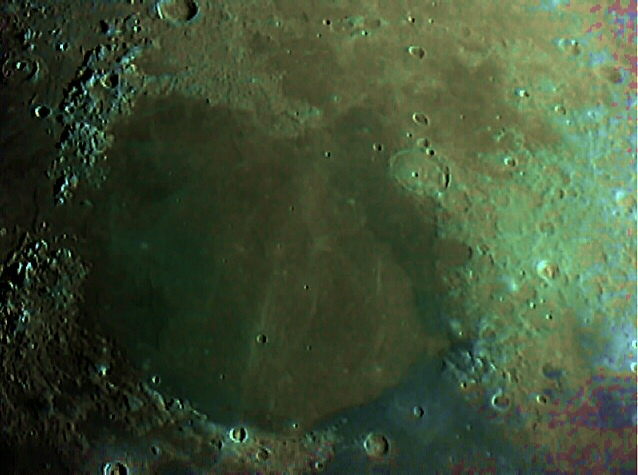|
|
| (3 intermediate revisions by the same user not shown) |
| Line 1: |
Line 1: |
| | __NOTOC__ | | __NOTOC__ |
| | =Colorful Friday= | | =Colorful Friday= |
| | + | <!-- Start of content --> |
| | <div class="post" id="post-1094"> | | <div class="post" id="post-1094"> |
| | | | |
| Line 6: |
Line 7: |
| | <p>[[File:2007_03_26_seren_1__2250ut.jpg|2007_03_26_seren_1__2250ut.jpg]]<br /> | | <p>[[File:2007_03_26_seren_1__2250ut.jpg|2007_03_26_seren_1__2250ut.jpg]]<br /> |
| | <em>image by [mailto:johnmcconnell9929@hotmail.com John McConnell]. </em></p> | | <em>image by [mailto:johnmcconnell9929@hotmail.com John McConnell]. </em></p> |
| − | <p>How can I resist a colorful view of Serenitatis, especially one taken with a 3″ ETX? And the picture is remarkably informative. First, the color comes just from exaggerating the saturation in Registax - its something any imager can try. I am impressed by the many different hues of color, and the well-known ultra-sharp color boundary along southern Serenitatis. Shadowing conveys an amazing feeling that the mare lavas flow onto the Imbrium ejecta on the basin’s west side, and as John commented correctly, it looks like the Serentitatis dark edge lavas poured out into Lacus Somniorum. I have always wondered why the northern and western sectors of Serenitatis have much less distinct color boundaries than the opposite sides. An interesting observation is that the Bessel ray coincides with a mare color boundary. This is at least partially correct, but a calibrated color [[PIA00132.jpg|image]] doesn’t show such a strong boundary, hinting that it may be a spurius effect, perhaps due to changing Sun angle. But most of the boundaries are real, and its a fun image!</p> | + | <p>How can I resist a colorful view of Serenitatis, especially one taken with a 3″ ETX? And the picture is remarkably informative. First, the color comes just from exaggerating the saturation in Registax - its something any imager can try. I am impressed by the many different hues of color, and the well-known ultra-sharp color boundary along southern Serenitatis. Shadowing conveys an amazing feeling that the mare lavas flow onto the Imbrium ejecta on the basin’s west side, and as John commented correctly, it looks like the Serentitatis dark edge lavas poured out into Lacus Somniorum. I have always wondered why the northern and western sectors of Serenitatis have much less distinct color boundaries than the opposite sides. An interesting observation is that the Bessel ray coincides with a mare color boundary. This is at least partially correct, but a calibrated color [http://photojournal.jpl.nasa.gov/jpeg/PIA00132.jpg image] doesn’t show such a strong boundary, hinting that it may be a spurius effect, perhaps due to changing Sun angle. But most of the boundaries are real, and its a fun image!</p> |
| | <p>[mailto:tychocrater@yahoo.com Chuck Wood]</p> | | <p>[mailto:tychocrater@yahoo.com Chuck Wood]</p> |
| | <p><strong>Technical Details:</strong><br /> | | <p><strong>Technical Details:</strong><br /> |
| Line 13: |
Line 14: |
| | <p><strong>Related Links:</strong><br /> | | <p><strong>Related Links:</strong><br /> |
| | Rükl charts 13, 14, 23 & 24<br /> | | Rükl charts 13, 14, 23 & 24<br /> |
| − | [http://www.lpod.org/?m=20070315 Another colorful view]</p> | + | [[March_15,_2007|Another colorful view]]</p> |
| | <p><b>Yesterday's LPOD:</b> [[May 3, 2007|A 42 Year Old Letter]] </p> | | <p><b>Yesterday's LPOD:</b> [[May 3, 2007|A 42 Year Old Letter]] </p> |
| | <p><b>Tomorrow's LPOD:</b> [[May 5, 2007|Schiller Times Six]] </p> | | <p><b>Tomorrow's LPOD:</b> [[May 5, 2007|Schiller Times Six]] </p> |
| − | <!-- Removed reference to store page -->
| |
| − | </em></div>
| |
| | </div> | | </div> |
| | + | <p> </p> |
| | + | <p> </p> |
| | + | <p> </p> |
| | + | <!-- End of content --> |
| | {{wiki/ArticleFooter}} | | {{wiki/ArticleFooter}} |




